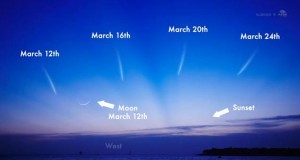 |
| This graphic shows the comet’s expected positions in the sky throughout March. Image credit: NASA |
On March 9 and 10, Pan-STARRS will be at its brightest, because that’s when it’s closest to the sun. Visible to the naked eye (but looking even better through binoculars or a telescope) at a dark site, the comet will appear as a bright “smear” of light low in the west up to an hour after sunset. And next week’s crescent moon can help locate Pan-STARRS: On March 12, the comet will lie to the moon’s upper left, and on the next night it will be on the moon’s lower right. After two weeks, the comet will have faded enough to require optical instruments to see it.
Discovery D-brief: Where Can I See Comet Pan-STARRS?
Comments